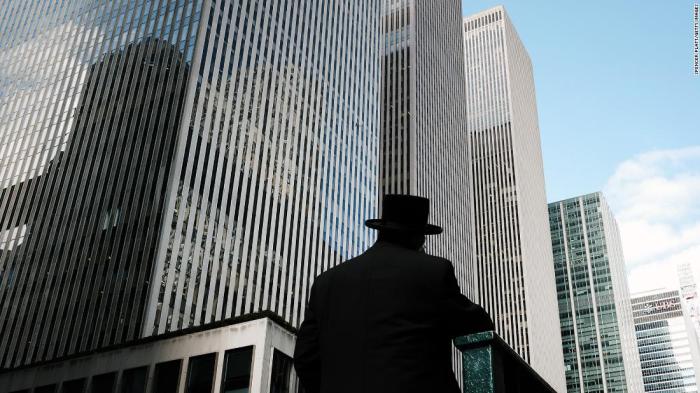
NYC Office Space Faces $50 Billion Value Loss
NYC office space to lose 50 billion in value – a headline that paints a stark picture of the challenges facing the city’s commercial real estate market. This dramatic decline isn’t just a number, it represents a fundamental shift in how we work and how we value office space.
The pandemic accelerated the rise of remote and hybrid work models, causing a ripple effect throughout the industry. Landlords are grappling with declining occupancy rates, while businesses are rethinking their office needs and exploring more flexible, cost-effective solutions.
The impact extends beyond the real estate sector, affecting the city’s overall economy. From reduced tax revenue to job losses, the decline in office space value has far-reaching consequences. This shift is forcing a re-evaluation of the role of the office in the modern workplace, with a focus on creating spaces that foster collaboration, innovation, and employee well-being.
The Economic Impact of the Decline

The $50 billion valuation loss in NYC office space represents a significant downturn in the city’s commercial real estate market. This decline has far-reaching implications for businesses, landlords, and the overall economy of New York City.
Impact on Businesses
The decline in office space value directly impacts businesses in several ways. Firstly, it makes it more difficult for businesses to secure financing for office space, as lenders are likely to be more cautious in providing loans against assets that have depreciated in value.
This can hinder business expansion plans and limit their ability to invest in growth opportunities. Secondly, the decline in office space value may also lead to a decrease in property taxes for businesses, as assessments are often based on market value.
This can provide some financial relief but may also signal a decline in the overall economic health of the city.
Impact on Landlords
Landlords are facing significant challenges due to the decline in office space value. They may experience reduced rental income as tenants negotiate lower lease rates or choose to relocate to more affordable locations. The decline in value can also make it harder for landlords to refinance existing mortgages or obtain new loans, as lenders may be hesitant to lend against assets that have lost value.
This can lead to financial strain and potential difficulties in maintaining and improving properties.
Consequences for the City’s Economy
The decline in office space value has a ripple effect on the city’s economy. It can lead to job losses in the real estate sector, including construction, property management, and related industries. As businesses struggle to adapt to the changing market, they may be forced to reduce their workforce, leading to a decrease in consumer spending and economic activity.
The news that NYC office space is set to lose $50 billion in value is a stark reminder of the changing landscape of work. This shift, driven by remote work and evolving needs, is mirrored in the blockchain world, where Gavin Wood, a prominent figure in the space, is exploring the concept of “chain mergers and acquisitions.” Gavin Wood: Chain Mergers & Just as companies are adapting to the changing demands of their employees, blockchain projects are exploring ways to merge and optimize their functionality, reflecting the dynamic nature of both the physical and digital realms.
It’s a fascinating time to observe these parallel trends and how they will ultimately shape our future.
Additionally, the decline in office space value can discourage investment in new developments and hinder the city’s ability to attract businesses and create new jobs.
Factors Contributing to the Decline: Nyc Office Space To Lose 50 Billion In Value
The decline in office space value in NYC is a multifaceted issue driven by a confluence of factors. The rise of remote and hybrid work models, spurred by the COVID-19 pandemic, has fundamentally altered the way businesses operate and employees work, leading to a shift in office space demand.
This has had a significant impact on the real estate market, contributing to the decline in office space values.
The Impact of Remote Work and Hybrid Work Models
The widespread adoption of remote work and hybrid work models has played a pivotal role in the decline of office space value. The pandemic accelerated the shift towards flexible work arrangements, as businesses and employees discovered the benefits of remote work, including increased productivity, reduced commuting time, and cost savings.
The news that NYC office space is set to lose $50 billion in value is a stark reminder of the changing landscape of work. This shift, driven by remote work and a re-evaluation of office needs, is mirrored in the blockchain world.
Gavin Wood, a prominent figure in the space, has been actively advocating for chain mergers and acquisitions, a strategy aimed at streamlining and optimizing blockchain infrastructure. This strategy, detailed in this article on Gavin Wood’s chain mergers and acquisitions , might offer valuable lessons for the future of office space as companies adapt to a more distributed and flexible workforce.
As a result, companies have begun to re-evaluate their office space needs, leading to a decrease in demand for traditional office space.
- Reduced Office Space Requirements:Companies are now realizing they can operate efficiently with a smaller office footprint, as remote work has significantly reduced the need for dedicated desks and workstations. This has led to companies downsizing their office space or opting for smaller, more flexible workspaces.
- Increased Flexibility:Hybrid work models have introduced greater flexibility for employees, allowing them to work from home, the office, or a combination of both. This flexibility has reduced the need for employees to be physically present in the office on a daily basis, leading to a decrease in demand for traditional office space.
It’s a crazy time for the office market, with NYC office space predicted to lose a whopping $50 billion in value. While we grapple with this shift, it’s fascinating to see how tech leaders like Vitalik Buterin, the co-founder of Ethereum, are shaping the future of work.
In a recent appearance on Bloomberg’s Studio 10, Vitalik Buterin discussed the potential for decentralized technologies to revolutionize how we work and interact with each other. This is a conversation worth paying attention to as we navigate the evolving landscape of office spaces and work culture.
The Pandemic’s Impact on Office Space Demand
The COVID-19 pandemic significantly impacted office space demand, accelerating the trend towards remote work and hybrid work models. The pandemic forced businesses to adopt remote work arrangements to protect their employees and ensure business continuity. This experience led many businesses to re-evaluate the necessity of traditional office space, leading to a decline in demand.
- Increased Uncertainty:The pandemic created a period of uncertainty and volatility in the economy, causing businesses to become more cautious about their long-term office space commitments. This uncertainty led to a decrease in demand for office space, as businesses opted to wait and see how the situation unfolded before making any major decisions about their office space needs.
- Shifting Employee Preferences:The pandemic also highlighted the importance of employee well-being and work-life balance. Many employees, having experienced the benefits of remote work, have expressed a desire for more flexible work arrangements, leading to a shift in employee preferences towards hybrid work models.
This shift in employee preferences has further reduced demand for traditional office space.
Rethinking Office Space

The decline in NYC office space value is forcing businesses to reconsider their traditional office models. The shift towards remote work and hybrid arrangements has accelerated the need for flexible and adaptable workspaces. This presents both challenges and opportunities for companies looking to optimize their real estate and attract and retain talent in a competitive market.
The Rise of Hybrid Work Models
Hybrid work models have become increasingly popular, with many companies adopting a mix of in-office and remote work arrangements. This approach offers several benefits, including:
- Increased employee flexibility and work-life balance:Employees appreciate the ability to work from home or a co-working space, which can improve their overall well-being and productivity.
- Reduced commuting costs and time:By working remotely, employees can save on transportation expenses and dedicate more time to personal commitments.
- Access to a wider talent pool:Companies can recruit and retain top talent from across the globe, expanding their potential workforce.
However, hybrid work models also present challenges, such as:
- Maintaining team cohesion and collaboration:Companies need to implement strategies to foster communication and collaboration among employees who work remotely.
- Ensuring equitable access to resources and opportunities:Remote employees need to have access to the same resources and opportunities as their in-office counterparts.
- Managing security and data privacy:Companies need to ensure that their data and systems are secure, regardless of where employees are working.
Emerging Trends in Office Design, Nyc office space to lose 50 billion in value
The changing work landscape is driving innovation in office design. Companies are prioritizing spaces that promote collaboration, creativity, and well-being:
- Activity-based working:This approach provides employees with a variety of workspaces, such as quiet zones for focused work, collaborative areas for team meetings, and social spaces for informal gatherings.
- Technology integration:Offices are increasingly equipped with advanced technologies, such as video conferencing systems, smart meeting rooms, and digital signage, to facilitate communication and collaboration.
- Focus on well-being:Companies are incorporating features that promote employee health and well-being, such as natural light, ergonomic furniture, and access to fitness facilities.
For example, Google’s offices are renowned for their innovative design, which includes spaces for relaxation, play, and creativity.
The Potential of Alternative Workspaces
The rise of hybrid work models and the changing needs of businesses are creating opportunities for alternative workspaces:
- Co-working spaces:These shared workspaces provide flexible and affordable options for businesses of all sizes, offering amenities such as meeting rooms, high-speed internet, and networking opportunities.
- Flexible office leases:Many landlords are now offering flexible lease terms, allowing businesses to rent space for shorter periods or on a pay-per-use basis, providing greater flexibility and cost savings.
- Virtual offices:These services provide businesses with a professional address and phone number, allowing them to operate without a physical office space.
The growth of co-working spaces, such as WeWork and Regus, demonstrates the increasing demand for flexible and collaborative work environments.
Future Outlook for NYC Office Space
The decline in value of NYC office space raises concerns about the future of this vital sector. While the immediate outlook appears uncertain, several factors suggest a complex and evolving trajectory. The market is likely to experience a period of adjustment and adaptation, with both challenges and opportunities emerging.
Factors Influencing the Future
The future of NYC office space will be shaped by a confluence of trends, including:
- Hybrid Work:The widespread adoption of hybrid work models is a significant driver of change. Companies are increasingly embracing flexible work arrangements, leading to a decrease in demand for traditional office space.
- Technology Advancements:Advancements in communication and collaboration technologies have further fueled the rise of remote and hybrid work. These technologies empower employees to work effectively from anywhere, reducing the need for physical office space.
- Changing Demographics:The evolving demographics of the workforce, particularly the rise of millennials and Gen Z, are also influencing office space preferences. Younger generations often prioritize flexibility, work-life balance, and access to amenities, which traditional office spaces may not always provide.
- Economic Conditions:The broader economic climate will play a significant role in shaping the future of NYC office space. Factors such as interest rates, inflation, and overall economic growth will influence investment decisions and demand for office space.

